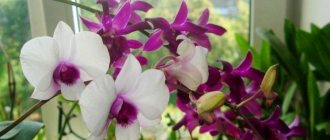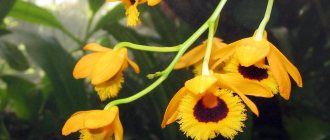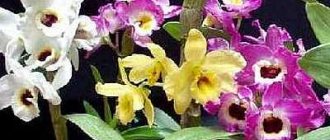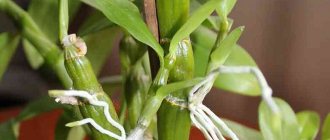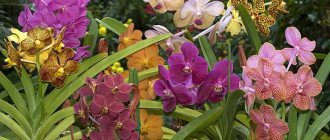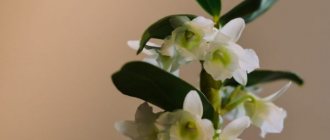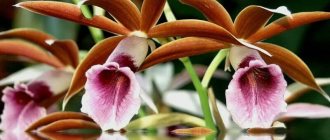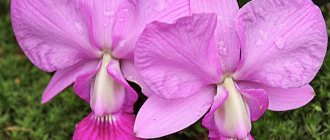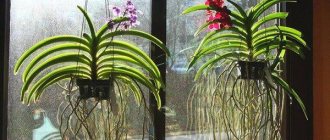One of the most beautiful types of Dendrobium orchids and, moreover, the most common in indoor floriculture is Dendrobium Nobile. The advantages of this orchid are its spectacular appearance, luxurious flowering, amazing aroma, so pleasant, slightly sweet and not at all cloying! Even novice gardeners can grow Dendrobium Nobile, because knowledgeable people compare this flower to geranium due to its unpretentiousness. In this article we will introduce you to this epiphytic beauty and tell you about the proper care of Dendrobium Nobile at home.
Description of the plant
A peculiarity of Dendrobium Nobile is the location of its peduncles - along the entire length of the pseudobulb
This type of orchid is most often found high in the mountains of India, Thailand, Nepal, Vietnam, and the Himalayas. Back in 1836, she was brought from India to Europe, where she amazed everyone with her unusual beauty. Translated from Greek, the name of the orchid “Dendrobium” sounds like “living on a tree”, and the prefix “Nobile” means “noble, excellent, noticeable or famous”. The second name of this orchid, Dendrobium Noble, very accurately characterizes this plant. A tall bush, about 60 cm, has an original, very impressive appearance. Purple with a yellow spot, pink, white or red flowers cover the trunk so thickly that the bush looks like a living bouquet. Its fleshy, straight stems (pseudobulbs) with a characteristic glossy tint are usually cylindrical, thickened in the lower part, and decorated with wide leaves in the upper part. Peduncles with large bright fragrant flowers appear on them in the second year of life.
The flowers of Dendrobium Nobile are united in inflorescences, which, depending on the age of the orchid and the variety of the hybrid, can have from 1 to 3 flowers. And the entire pseudobulb, if you count it, can be decorated with from 50 to 70 flowers. The diameter of one flower can reach 10 cm, but on average it is from 5 to 8 cm. Natural species of Dendrobium nobilis have white petals with purple tips and a cream-colored lip with a pinkish edging and a dark purple throat. And hybrid varieties come with white, orange, purple, lilac, dark purple flowers, even variegated ones. The shape of the petals is ovoid with elongated sepals. Flowering occurs in February - March. The shoots of an adult flowering Dendrobium are literally strewn from base to top with large, unusually beautiful flowers. Each flower stays on the peduncle for up to two months.
Hybrid varieties of Dendrobium Nobile can bloom twice a year. Or they may miss a year in flowering. But then, usually the next year, the orchid lays a much larger number of flower buds, since the shoots of the missed year also begin to bloom.
The Dendrobium Nobile orchid belongs to the sempoidal type, i.e. new rosettes of leaves (growths) appear on rhizomes (rhizomes) at the base of old ones. Each such sprout (shoot, pseudobulb) lives from two to four years. When young it is slender, and as it ages it bends over and can take on a lodging shape. Over time, the pseudobulb grows longer than a meter, becomes bare and, having formed daughter rosettes, dies. In the axils of alternately growing leaves, flower buds or new shoots are formed, which can subsequently be used for propagation by cuttings.
The shape of the Dendrobium Nobile orchid flowers, their color and aroma do not leave any gardener indifferent. Even experts in this culture admit that this orchid is the most suitable for growing at home.
Soil and pot
In nature, dendrobium grows on tree bark, and accordingly, at home it prefers similar soil. You can find a special substrate made from tree bark on sale, or you can crumble it into regular soil yourself.
Read about which ready-made soil for dendrobium is best to buy in a store and how to make it yourself here.
The pot can be narrow, but it must be deep - this way the plant can take root as if along a tree trunk. There must be holes at the bottom through which excess moisture will drain into the pan.
Important to know when purchasing
Usually, a flower newly purchased in a store looks great, blooms well and does not require special care for some time. The owner of Dendrobium considers himself the happy owner of an ideal, completely unpretentious flower. We will disappoint you - without proper care, the plant most likely will not bloom again and may die. The thing is that when growing and preparing orchids for sale, greenhouses use strong drugs - growth stimulants and long-acting fertilizers. They provide plants for sale with a supply of vitality and nutrients only for a few months. The sooner the plant gets into conditions that are comfortable for its existence, the sooner the owner begins to competently take care of his pet, the longer Dendrobium Nobile will be able to delight others with its presence and flowering.
Reviews
Maritanna. “I want to share my joy and thank all orchid lovers who responded to my request. But first things first. I really love orchids. But whenever I buy a new specimen, I begin to doubt my abilities and, as a result, I acquire an old familiar phalaenopsis, only in a different color. But about six months ago, my friend, while leaving for the country, brought me a completely incomprehensible creature. In the pot sat a bare stick consisting of thickened segments. A friend said it was an orchid, but she didn’t know what type. I placed the strange guest on the window of my “old people” and tried to revive her for several months. Nothing worked. Then I contacted the orchid lovers club. And there they quickly explained to me that this is a bamboo orchid, which is simply in a dormant period.
Having calmed down, I began to wait for her to wake up. And yesterday I discovered a small green dot at the base of my “stick”. The time has come, the guest wakes up, and I am incredibly happy. Thanks everyone! I’ll be waiting for the flowers to bloom!”
Olga Ivanovna. “My story is about the favorite of the whole family - Dendrobium nobilis. A year ago I bought it at a flower shop. It was a continuous cascade of snow-white flowers, sitting tightly on the trunk. I fell in love at first sight and couldn't leave it in the store. The sellers tried to talk about his quirks and requirements, but I was in a hurry, so I didn’t listen well. As a result, all the instructions of the specialists turned out to be unnecessary. Our Snowball was happy with everything: the eastern side of the window, not very frequent watering, and the sun's rays. It bloomed beautifully, then formed three new shoots, went dormant in the fall, and now it’s all in buds again. Perhaps you just need to love the flower, and it will respond in kind.”
Anna. “I acquired my Dendrobium Nobile quite by accident. In fact, I am an experienced cactus grower. While choosing a new cactus in the store, I noticed a lonely stem without leaves standing in the very corner. For some reason I felt incredibly sorry for him. And together with the cacti, he went to my home for a purely symbolic fee.
Amateur flower growers really like the Bamboo Orchid.
There was a tag stuck into the pot. That's how I found out the name of my guest. I cared for it the same way I cared for cacti. Imagine my surprise when my Nobile began to grow, and then bloomed with magnificent lilac flowers with a wonderful smell. At that moment I realized that besides my favorite cacti, there is beauty in nature.”
Home care
In nature, Dendrobiums are plants with a pronounced seasonality. Their development cycle includes periods of active growth, flowering and dormancy. And for each such time period you will have to create your own conditions in your home.
The Dendrobium Nobile orchid constantly develops throughout the year. Four conventional periods of her life can be distinguished:
- Vegetation . At this time, new shoots appear at the base of old pseudobulbs (babies).
- Formation of new pseudobulbs . The young sprout develops and catches up in size with the old pseudobulb, i.e. itself becomes a pseudobulb.
- The period of laying peduncles . At this time, the plant is in a dormant period.
- Bloom . At this time, flowers bloom on the peduncles. Different hybrid varieties have different durations of this period.
Let's consider the basic rules for caring for the Dendrobium Nobile orchid at different periods of its life.
Lighting and flower location
It is known that the light-loving orchid does not tolerate direct sunlight well, although without bright, but diffuse sunlight for 12 hours a day, it is even worse. Therefore, when choosing a place for a pot, pay attention to the windowsills in the eastern or western direction. It is also possible to grow in the south, provided that the plant is protected from the rays of the midday sun scorching through the glass using light blinds or curtains. When growing a flower near northern windows, you will need to use artificial sources of daylight so that the orchid does not suffer from lack of light. Outdoors during the summer months it thrives in both light shade and sun. The brighter and longer the lighting, the more abundant and colorful it will bloom. Pay attention to the leaves. If they are too dark, there is not enough light. If the leaves of a plant are too light on a sunny windowsill, they will burn through the glass and may get sunburned. The Dendrobium Nobile orchid should have lush green leaves.
Temperature
Optimum room temperature during the day: in summer 22 – 28 degrees. and 15 – 20 gr. in winter. This orchid easily tolerates fairly high temperatures, up to 32 degrees, with comfortable ambient humidity. To stimulate flowering, the plant needs a difference between day and night temperatures within 5 - 10 degrees. Temperatures below 15 degrees are considered critical for summer. at night and above 33 degrees. during the day.
During flowering, it is advisable to reduce the temperature and maintain about 18 degrees. – then the flowering itself will last longer.
If Dendrobium Nobile is kept outdoors (in the garden, on the veranda), the difference in daily temperatures will occur naturally. If the flower is kept indoors all year round, at night, to reduce the temperature, you need to ventilate the room well, if necessary, turn off or block the heating devices, do wet cleaning and spraying.
This may be interesting: Cattleya - orchid care at home
With the onset of autumn, the temperature of the flower should be reduced to 20 - 22 degrees. in the afternoon and about 16 degrees. at night.
Watering Dendrobium Nobile
Sometimes the room is dry and hot, and sometimes it’s cool and damp. Focus on the microclimate in which your flower has to live. Dendrobium Nobile is watered as often as its substrate requires. If it dries out, it needs another watering. In summer this happens two to three times a week, in spring and autumn - once every 10 to 15 days. During the dormant period, the flower may stop consuming moisture altogether and is practically not watered until new flower shoots appear.
Water for irrigation is used that is soft, clean, warm, filtered or settled for 24 hours and heated a couple of degrees above room temperature. You can use boiled water after it has cooled to a temperature a couple of degrees higher than the air in the room.
Watering is carried out in different ways. It is best to place the flower pot in a bowl of filtered warm water so that only the lower part of the pot is in the water. Within a few minutes, the substrate will be thoroughly saturated with moisture, and the pot can be removed and placed in a tray to drain excess liquid. We recommend combining such watering with fertilizing by adding liquid fertilizers for orchids to the water.
You can simply add water to the pan during the next watering until it stops being absorbed into the substrate. Then after 20 - 30 minutes, excess moisture must be drained from the pan.
At the end of the growing season, while preparing the Dendrobium for flowering, reduce watering by half and stop feeding. At this time, we recommend periodically giving the orchid a bath in a hot shower with a water temperature of 35–40 degrees. After an evening bath, blot water in the axils of the leaves to prevent the trunk from rotting.
Such bathing will not only clean the leaves of the plant, but also improve gas exchange in its tissues and stimulate future flowering. When flower buds appear, watering and feeding should be resumed.
Humidity
Dendrobium Nobile orchids grow best in normal and high ambient humidity. The minimum permissible humidity limits are 40% - 50%. Hot, dry weather slows down the growth of an orchid, and sometimes stops it altogether. It is better if the humidity is higher. To increase it, wet stones, moss, and large pieces of pine bark are placed in the tray. Do not place the pot in water, so as not to cause rotting of the roots. To retain moisture in the pot, cover the surface of the substrate with moss. Frequent spraying with a fine spray bottle is used both on the bush and in the surrounding air. This is especially true for hot summer days and with the onset of the heating season.
Soil for Dendrobium Nobile
To plant and replant Dendrobium Nobile, use purchased soil for orchids or epiphytic plants. It’s also not difficult to prepare the substrate yourself if you live near a pine forest. The basis of the soil for orchids are pieces of old pine bark measuring from 1 to 3 cm, which must first be thoroughly dried and then boiled in water a couple of times to ensure that it is cleaned of any fungi and viruses. It is also necessary to add pieces of charcoal to the substrate to prevent soil acidification and root diseases. You can add fern roots if you have them, bottle caps, coconut fiber. If your flower is on a south-facing window, you should add pieces of sphagnum moss to the substrate - it will retain moisture.
If the pot is placed on a north-facing window, then small pieces of polystyrene foam should be added to the substrate to loosen it further. The presence of a small amount of peat in it has a positive effect on the quality of the soil. This is a slightly strange substrate that orchids love. It does not serve to obtain nutrients, but rather to secure the Dendrobium roots in the pot and provide better ventilation. We recommend pouring boiling water over the substrate you prepared yourself, letting it sit for about 15 minutes, then draining the water and waiting for the soil to dry. Now the soil is ready for use.
Transplanting Dendrobium Nobile and choosing a pot
Dendrobium Nobile does not need frequent replanting into a new pot and new substrate. He does not tolerate changes in environment and conditions of detention. Even after purchasing an orchid, it is transplanted into a new pot next spring, not earlier. A healthy plant will need the next transplant in three to four years. In addition, Dendrobium Nobile feels better in a cramped pot when the gap between the roots and the walls of the pot does not exceed 2 cm.
Transplantation is only necessary in a few cases. And then they try to carry it out only after flowering has ended:
- The substrate turned to dust. The roots have nothing to grab onto and do a poor job of holding the flower in the pot.
- The root system filled the entire space in the pot and displaced all the substrate from it. The roots are sticking out. The pot became clearly too small.
- If you notice a brown coating, rot, or the soil has become salty on the rhizome, then do not wait for trouble and, without waiting for the end of flowering, transplant the flower into a new substrate, having previously cut off the damaged and diseased parts of the root.
So, for replanting, prepare a pot of the required size.
It should be quite high so that, in addition to the plant, it can accommodate a layer of drainage of at least three to four cm made of heavy, large, but sterilely clean stones. This is necessary so that the orchid, having a relatively weak root system and heavy, fleshy leaves, cannot overturn the pot.
The pot does not have to be transparent, since the root system of Dendrobium Nobile, unlike Phalaenopsis, does not take part in photosynthesis.
It should correspond to the size of the root system of Dendrobium Nobile and be 2 cm larger than the diameter of the previous one. Do not forget that the flower prefers a cramped pot.
It is better if the pot is made of clay with good drainage holes. On sale you can find special pots for orchids made of ceramics, which have holes not only in the bottom, but also in the walls, which significantly improves gas exchange in the root system. Before use, we recommend calcining such a pot in the oven, cooling and then soaking for two hours in clean water. The pot is now ready to use.
Place a layer of drainage on the bottom of the pot. For drainage, in addition to stones, use the largest pieces of pine bark measuring 3 - 4 cm. We recommend not using expanded clay as drainage, since it contains calcium, which will salt the substrate.
Remove the flower from the old pot and completely clean the roots from the substrate. To better remove the soil, soak the root system in a basin of warm water. This way you can easily clean the roots without damaging them. If you do see damaged or broken roots, cut them with a clean, sharp knife and treat the sections with activated carbon. Hold the roots in the air - let them dry out and heal the wounds.
Now you can place the orchid roots in the center of the new pot on the drainage layer, and cover them with new substrate. If the plant is large and needs support, it’s time to install it and tie the flower to the support. Do not compact the soil. It’s better to shake the pot a little so that all the voids between the roots and the walls of the pot are filled. Do not cover young pseudobulbs with substrate so that they do not rot during watering. It is advisable to leave 2–3 cm to the top edge of the pot, in case the rhizome grows, so that you can add substrate. For a couple of weeks after transplantation, set the flower aside from sunlight, let it stand in partial shade at a temperature of about 20 degrees. Do not water it for three days, let possible wounds on the roots heal. If old leaves begin to turn yellow, don’t worry, their lifespan has expired. The orchid will get used to the new substrate and grow new ones.
Growing an orchid on a block
In addition to the pot, blocks are used to grow Dendrobium Nobile, on which orchids also grow well. Blocks are special materials to which this orchid can be attached. These can be hanging baskets made of slats, decorative supports in the form of driftwood. The block can be pine bark, cork oak bark, or a tree fern block. Methods of growing Dendrobium on blocks have recently become popular
This may be interesting: Use of succinic acid for orchids
Top dressing
Orchids, in particular Dendrobiums, love regular feeding. From soil that is poor in composition, roots cannot extract mineral salts and other elements useful for healthy growth. Therefore, special fertilizers for orchids are used only in the form of liquid solutions. When watering the roots of Dendrobium Nobile, they are added to a tray or basin with water in doses reduced by 2 times from those recommended by the manufacturer, and during foliar feeding, when spraying the leaves with a small spray bottle, the dose of the drug is reduced by 5 times.
It is important to remember that in Dendrobium Noble, not only growth buds awaken in the spring, but also flower buds. Feeding with fertilizers, which contain a lot of nitrogen, can lead to the formation of a large number of new rosettes - babies. If you continue to feed the orchid with them, you may not wait for flowering. Therefore, when the sprouts grow to half their size, change the fertilizer to one that contains more phosphorus than nitrogen.
We strongly do not recommend placing fertilizers in tablets or granules dry into the substrate. We also do not recommend using homemade fertilizers or using folk remedies as them. Orchid roots are very delicate and sensitive; from an overdose they can burn, get sick or die. Is it worth the risk?
Dormancy period and preparation of Dendrobium Nobile for flowering
Surprisingly, different gardeners in different places have Dendrobium Nobile orchids bloom at different times of the year. This depends on the growing conditions and varietal characteristics of the hybrids. And there are currently an incredible variety of hybrid forms of Dendrobium Nobile!
The plant must prepare in advance for each flowering. And, the main thing here is a well-organized rest period for Dendrobium Nobile. It is at this time that the plant begins to prepare for the next flowering.
The Dendrobium Nobile orchid has bloomed, what to do next? Do not remove yellowed old pseudobulbs immediately. They will also serve as food for young growing bulbs. Only cut them off when they are dry. Sprinkle the cut areas with crushed coal.
Move the pot to a cool room. The temperature during the day should be between 16 - 20 degrees, at night - about 10 - 12 degrees. In the southern regions, it can easily winter on a glassed-in loggia if the temperature there at night does not drop below 10 degrees.
Reduce watering and then stop altogether. Feeding too. If the pseudobulbs are severely wrinkled, lightly spray the substrate and leaves of the flower. It is not necessary to create artificially high air humidity during this period.
Watch the flower. After about a month, with the onset of spring, when night temperatures rise, the plant begins to emerge from hibernation. Flower buds should appear in the internodes of the orchid's pseudobulbs. Young pseudobulbs will begin to turn into flower stalks. Now you can take the pot to its permanent place in the sun.
From early spring the flower should be illuminated as brightly as possible. The temperature difference between day and night should be at least five degrees. Watering should be plentiful, with the substrate thoroughly drying between waterings. Feeding is moderate. Fulfillment of these conditions guarantees you gorgeous flowering.
The flowering period lasts from a month to two. The ambient temperature plays a big role here. The higher it is, the faster the orchids will bloom. The ideal temperature for flowering is 18 degrees.
What to do with Dendrobium Nobile after flowering? At the moment when flowering ends, the above-ground part of the plant enters the phase of active growth, which over time leads to the formation of new rosettes - children. Green mass is growing until the end of August. You should not touch old pseudobulbs, because they will provide additional nutrition to young, newly emerged children.
Features of flowering
Flowering takes place in the last months of winter and spring. To admire the blooms, proper care is necessary at this time.
How to care during flowering?
Photo of an orchid: gorgeous bloom captivates the eye
In order for an adult plant to feel comfortable and produce a peduncle, it is necessary to ensure the correct development cycle, which should include a phase of active growth and rest. If these conditions are neglected, instead of a peduncle, the orchid will delight the owner with young shoots - children that will develop from the pseudobulb.
Thanks to breeding work, you can see different colors of dendrobium flowers. Flowering lasts from 2 weeks to 1.5 months.
In January, you need to reduce watering and move the pot with the plant to the most illuminated place. But the plant can get burned from direct sunlight.
If flower stalks do not want to appear, flowering can be stimulated by applying phosphorus-containing fertilizer.
If this does not help , the dendrobium is given a shower with optimal water at a temperature of +35-40 degrees, no more.
How to care after flowering?
Orchid transplant
Only in some plants the foliage falls and the dendrobium enters a dormant period, preparing for a new flowering.
After flowering, you need to cut off the peduncle if it has changed its color, reduce watering and place it on the windowsill in a cool room. Constantly wet soil will cause the rhizomes to rot.
In its natural environment, dendrobium is always in active growth. Therefore, if the plant has not gone into hibernation, it is recommended to provide additional lighting by installing a phytolamp above it.
Propagation of the Dendrobium Nobile orchid
There are many ways to propagate Dendrobium Noble. We will describe the simplest and most accessible of them.
Reproduction of Dendrobium Nobile with the help of children
This method is the easiest. When your pseudobulb produces a baby rosette instead of a flower, you will let it grow a little and form. After this, use a sharp, clean tool (knife, blade, pruning shears) to carefully cut the baby from the mother shoot. Keep it in the air for a couple of hours - let the wound on the cut heal. Powder the cut with crushed activated carbon and plant it in a slightly damp substrate. To create a greenhouse effect, cover the pot with polyethylene or a glass jar. Usually, rooting is quick and successful. Flowering can be expected a year after transplanting into a pot.
Propagation of Dendrobium Nobile by cuttings
This is also an easy way. Cut off the old pseudobulb (without leaves) at the root. Cut it into pieces so that each has 2 - 3 dormant buds. Powder the cut areas with crushed coal. Prepare a container with a lid filled with moist sphagnum moss as a substrate. Place the cuttings in a container and cover with a lid to create a greenhouse. Select a place for rooting in bright, diffused light and a temperature of 22 degrees. If necessary, moisten and ventilate. The roots will form in three weeks, and then the children will begin to grow up. When they get stronger and their roots grow to 5 cm, you can transplant them into separate pots with orchid substrate.
Reproduction when dividing an adult bush
This method is somewhat more complicated. The orchid must be mature, healthy, and have a sufficient number of sprouts. If you have a young plant and only two sprouts, don’t risk it, you may be left without your Dendrobium Nobile altogether. It is advisable that the link you choose to separate from the bush has both old pseudobulbs and adult and young shoots with roots. Then, during the next transplant (no more than once every three years), you can carefully cut off the link you have chosen from the main rhizome (rhizome). Treat all wounds with crushed activated carbon. Leave the delenka for a day in partial shade in the air so that all the wounds dry out. Now plant the new bush in a separate pot with orchid soil. Next, we care for it in the same way as for a transplanted plant.
Before carrying out this division, we recommend watering the bush well so that the root system becomes more flexible and pliable. If an adult bush has several such links, then it can be divided into more parts. Just make sure that both old and young shoots remain on the mother plant in sufficient quantities, at least 2 - 3 pieces. Specimens obtained by dividing the bush should bloom next year.
This may be interesting: Cambria Orchid - home care
Reproduction using a young pseudobulb
This method is longer and more unreliable. But, if possible, you can get several orchid seedlings from one bulb.
We choose a young, strong pseudobulb that has not yet bloomed. We cut it from the mother bush with a clean, sharp tool. In a container with a lid we place a layer of damp sphagnum moss on which our pseudobulb will lie for the appearance of new rosettes. The container lid must be kept closed. Choose a bright place for germination, with a temperature of about 22 - 25 degrees. Watch the cutting. About a month will pass when young orchids begin to form on it. When the sprouts have their own roots 3–5 cm long, they can be planted in their own pot with orchid substrate. Such orchids will bloom in a few years, when they become sufficiently mature plants.
Recommendations for flower growers
When transplanting, it is important to thoroughly inspect the measles system for the presence of diseases and pests.
Remember that dendrobium root shoots are very fragile. Before replanting the plant, thoroughly soak the earthen lump removed from the pot to easily untangle the roots and free them from parts of the old substrate. Important! You will need to prevent infection of the weakened root - treat the tools and the pot itself. It is also advisable to disinfect the entire substrate and drainage.
The water in the orchid's tray should not stagnate - this is a direct threat to the death of the indoor flower, both in winter and summer. Flower growers also do not recommend abusing fertilizers. You can feed an exotic perennial only 1-2 times a month, while strictly observing the timing - during the active flowering phase.
Diseases of Dendrobium Nobile and other problems in growing this orchid
Improper care of plants often becomes the main cause of their diseases. Orchids are no exception. We will introduce you to some of the most common problems when growing Nobile orchids and ways to solve them.
Why do the leaves of Dendrobium Nobile turn yellow? The lower leaves of the seemingly healthy plant began to turn yellow and fall off.
- Don't worry, this is a natural process of aging leaves, they usually live no more than two years.
Dry brown spots appeared on the leaves.
- This is a sunburn. Such spots appear on leaves after spraying them in sunlight, especially if the sun's rays shined directly on them through a window glass. The orchid must be accustomed to the sun gradually, then the leaves will not get sunburn. And it is better to spray in the early morning, when the sun is not so hot.
Wet spots appeared on the leaves.
- Leaves can rot if the orchid is sprayed at low temperatures. You should not spray if the room temperature is below 20 degrees, so as not to provoke the occurrence of fungal diseases (gray rot).
Rot appeared at the junction of the leaf and the stem.
- This happens when water gets into the axils of the leaves while bathing the flower or spraying the leaves. After all water procedures, you should blot droplets of water from the axils of the leaves with a napkin, especially in the evening, when hopes for its natural evaporation decrease.
Why doesn't Dendrobium Nobile bloom? The flower did not bloom at the expected time.
- Perhaps he didn't have enough coverage during the year. Dendrobium Nobile orchids are the most light-loving orchids. They need at least 12 hours a day, every day, all year round.
- Perhaps you did not organize a dormant period for it, during which flower buds are laid for future flowering.
- Perhaps you overfed your orchid with nitrogen fertilizers, and you developed a lot of new growth shoots instead of flowering. Correct the mistakes, and your orchid will definitely bloom in the next life cycle.
The roots of the orchid began to rot.
- This can happen from frequent waterlogging of the substrate. Rot will spread from the roots to the stems. The plant will begin to wither, the leaves and pseudobulbs will become covered with weeping brown spots. The flower urgently needs to be replanted. Remove it from the pot. Shake off the substrate. To remove it better, soak the roots in a bowl of warm water - then it will fall off on its own. Inspect the root system and crown. Remove all affected and damaged areas of roots and leaves. Sprinkle the wounds with crushed activated carbon and air dry for a couple of hours. If the Orchid is very badly damaged, treat it with Mikosan biofungicide. After this, transplant into a new substrate. If you use the old pot, rinse it well and disinfect it. Do not water the flower for a couple of weeks after transplantation - let its wounds heal.
Watering after transplanting
If after transplanting a dendrobium orchid the leaves turn yellow, then the plant definitely does not have enough moisture. Therefore, immediately after planting, place the indoor flower in a well-lit place with diffused light. Be sure to increase the humidity level in the room. After this, do not water the flower for 2-3 days so that the roots “set.”
Dendrobium is a tropical perennial, so water the plant moderately but frequently. It is believed that the conditions for its watering should be as close as possible to the conditions of the orchid’s natural habitat. In the summer, indoor flowers should be watered more often, since the ambient temperature is higher and evaporation is greater.
But in cold winter, watering is reduced to a minimum. Many gardeners say that it is best to water the plant in the summer with a warm shower, just to freshen the leaves. After such a shower, be sure to dry the orchid leaves with a cotton swab and use ear swabs to wipe the axils of the leaves, as well as the buds. This will prevent moisture stagnation. When watering, use only purified water at room temperature. Otherwise, heat-loving plants will freeze and the root system will rot.
Pests of Dendrobium Nobile
The best prevention of insect damage to a flower is proper care of it. If the humidity, light and temperature regimes are violated, the plant is immediately attacked by sucking parasites. Let us introduce you to some of the most persistent ones.
Thrips
Thrips are small winged insects that live on the undersides of leaves. They feed on plant sap. Damaged leaves turn yellow and fall off. Flower petals dry at the edges.
Aphid. Insects settle very quickly on young leaves and flowers and suck out cell sap. The leaves become deformed, turn yellow, and fall off. The buds do not open and dry out. Read how to get rid of aphids on indoor plants here.
Scale insects on orchid leaves
Shield. The presence of a pest can be determined by the plaques that appear on the surface of the leaf blades and shoots of the orchid. Parasites hide under brown shells and drink cell sap. The plant loses its strength, the leaves begin to turn yellow and fall off.
Spider mite. You can recognize the appearance of the pest by the thin cobwebs that cover the leaves and shoots of the orchid. Most likely, the air in your room is too dry. These insects also feed on plant sap. Small spots from tick injections on the surface of the leaf turn into large spots. Affected leaves and flower stalks die.
The first remedy for any insect pests is to shower in the bathroom under running warm water. Try to wash off as many parasites as possible from the leaves and shoots. What remains, try removing it with a napkin soaked in a water solution of laundry soap. Manually collect the scale insects using the same napkin and tweezers.
You are unlikely to be able to cope with the entire colony - insect pests of indoor plants are very prolific. In addition to adult flying and crawling individuals, the colony contains their larvae and eggs, which are firmly attached in the sinuses, folds, and roots. Therefore, we recommend that in case of severe damage, you use chemical control agents - insecticides. There are a large number of such drugs on sale. You can spray with one of the drugs: Aktara, Actellik, Fitoverm. Usually, re-treatment is necessary after 10 - 15 days, read the instructions.
Reproduction methods
Bamboo orchid can be propagated by simply dividing the bush . It is important that each separated element has at least 3 pseudobulbs and necessarily roots. After separation with disinfected instruments and treatment with an antiseptic, each piece is placed in its own pot.
Another method of propagation of D. nobile is to separate the children from the main stem with a section of the mother plant. It is necessary to take into account the size of the shoots of the baby (more than 5 cm) and the length of its roots (at least 3 cm).
A little about signs
According to Eastern philosophers, there are many signs associated with the presence of this mysterious flower in an apartment.
- It is believed that Dendrobium Nobile will bring peace and prosperity to married couples. If a couple is in a civil marriage, then the appearance of this flower can lead to discord and even a break in the relationship.
- It is not advisable to place an orchid in the bedroom. It is believed that the flower will take away the owner’s strength and he may become depressed.
- The plant has a negative effect on people with unstable psyches.
- For creative people, it helps awaken inspiration and new strength.
- It gives women cheerfulness and prolongs youth.
- The presence of a blooming Dendrobium Nobile orchid in the house is a talisman against guests with bad intentions and all sorts of ill-wishers. If such a person appears as a guest, the orchid will worsen his health and force him to leave your home.
The color of orchid petals also has its effect.
- Orchid species with red and purple flowers are believed to help break bad habits.
- Yellow and orange orchids promote an active lifestyle and bring success in financial matters.
- White and pink flowers relieve depression and bring harmony to the state of mind.
Landing rules
The roots of a bamboo orchid require good aeration and rapid drainage of moisture to prevent rotting. Therefore, when planting, use a standard substrate, which consists of pieces of pine bark with the addition of moss and foam.
When planting D. Nobile, you should not take very large pots - orchids will bloom more profusely . But the signal for transplantation is the protrusion of the roots from the vessel in which it grows. It is most convenient to grow bamboo orchids in opaque plastic pots, in the walls of which you can easily make many holes for aeration.
Before planting in a pot, you need to pour drainage , then a little substrate. Be sure to inspect all the roots of the orchid, trying to act very carefully, since the roots are fragile. Damaged and diseased areas of the root should be removed by treating the exposed areas with charcoal.
Place the roots in a pot and cover with soil. After planting , water only a week later , limiting yourself to spraying. Provide support for the plant at first.
D. Nobile transplant is performed only when necessary :
- Small pot;
- Roots are damaged;
- The substrate was caked.
Typically this operation is repeated every 3 years. The technology consists of carefully removing the orchid from the old pot, examining and performing preventative procedures for the roots , and placing it in a new vessel.
ADVICE! Replant only healthy and faded plants!
Among the risks during transplantation are the possibility of damage to the roots due to their fragility, as well as the likelihood of rotting, so you should not water the transplanted orchid for about a week.
Common diseases, their treatment and prevention
One of the dangers for a flower is its pests :
- Spider mite;
- Thrips;
- And aphids.
These insects suck out nutrients from the plant, which leads to weakening and even death of the orchid . For preventive purposes, regular inspections should be carried out and dry air should not be allowed near the plants. Treatment is treatment with insecticides.
Fungal infections include:
- Phyllosticosis - small yellow spots on leaves and bulbs that gradually grow and turn black; the disease appears from high humidity; fungicide treatment required;
- Fusarium - brown and black spotting on all parts of the plant; it cannot be treated with chemical treatments - if it is not possible to remove the infected areas, then the plant is destroyed entirely;
- Gray rot - watery spots on the petals, spreading to other parts; Only weak specimens are affected, therefore, for the purpose of prevention, it is necessary to observe the conditions for keeping flowers, and if infected, treatment with a fungicide is required.
Bacterial rot includes wet rot and bacterial spotting. They occur when transporting orchids, when the roots are in wet moss and the temperature is far from ideal for the plant. If the flower is damaged you need :
- Isolate and remove damaged areas;
- Treat sections with iodine;
- Spray the plant with Bordeaux mixture.
Caring for flowering specimens
The plant blooms for a very long time
Each dendrobium blooms at different times of the year and lasts from 8 to 12 weeks. Caring for a flowering specimen is not difficult, the main thing is to take into account some rules:
- When preparing plants for such an important stage, it is necessary to ensure a sharp temperature difference - 6-7° both day and night. In nature, this is a natural phenomenon, so gardeners at home also try to reproduce it.
- They stop watering the plant for a while to force it to bloom and grow a new shoot with roots. Then watering is resumed. As soon as the new stem reaches the height of the old pseudobulbs, the plant is stopped watering again and the temperature is lowered to 12°. Do not water until it produces flower buds. Otherwise, instead of flowers, the plant will have children.
This type of care for the dendrobium nobile orchid during the flowering period is carried out in winter.
Difficulties in growing
Often the cause of the appearance of diseases and parasites on this plant is illiterate and untimely care:
- the tips of the leaves turn yellow due to excess sunlight or overfeeding with fertilizers;
- wilting and shedding of leaves is caused by excessive watering or lack of daylight;
- watering with cold water leads to rotting of the root system and the development of the disease - root rot;
- Due to lack of nutrients, flowers stop growing and stop blooming.
